Leadership and Management Report: Case Study Analysis
VerifiedAdded on 2020/03/02
|6
|1073
|179
Report
AI Summary
This report provides an introduction to management, focusing on leadership principles and their application within the context of a case study. The report begins by defining leadership and management, highlighting key traits such as vision, motivational skills, and effective communication. It then delves into the Contingency Theory of Leadership, explaining how leadership styles are influenced by various situational and organizational factors. The core of the report is a case study analysis of Phillip Mills, the founder of Les Mills, examining how he applies leadership principles and motivational skills. The analysis explores how Mills' approach aligns with the Contingency Theory, emphasizing his ability to foster a healthy work environment, centralize operations, and motivate employees. The report concludes by summarizing Mills' effective leadership, which has contributed to the success of Les Mills in the fitness industry, and references relevant academic sources to support the analysis.

Running head: INTRODUCTION TO MANAGEMENT
Introduction to Management
Name of the Student
Name of the University
Author Note
Introduction to Management
Name of the Student
Name of the University
Author Note
Paraphrase This Document
Need a fresh take? Get an instant paraphrase of this document with our AI Paraphraser
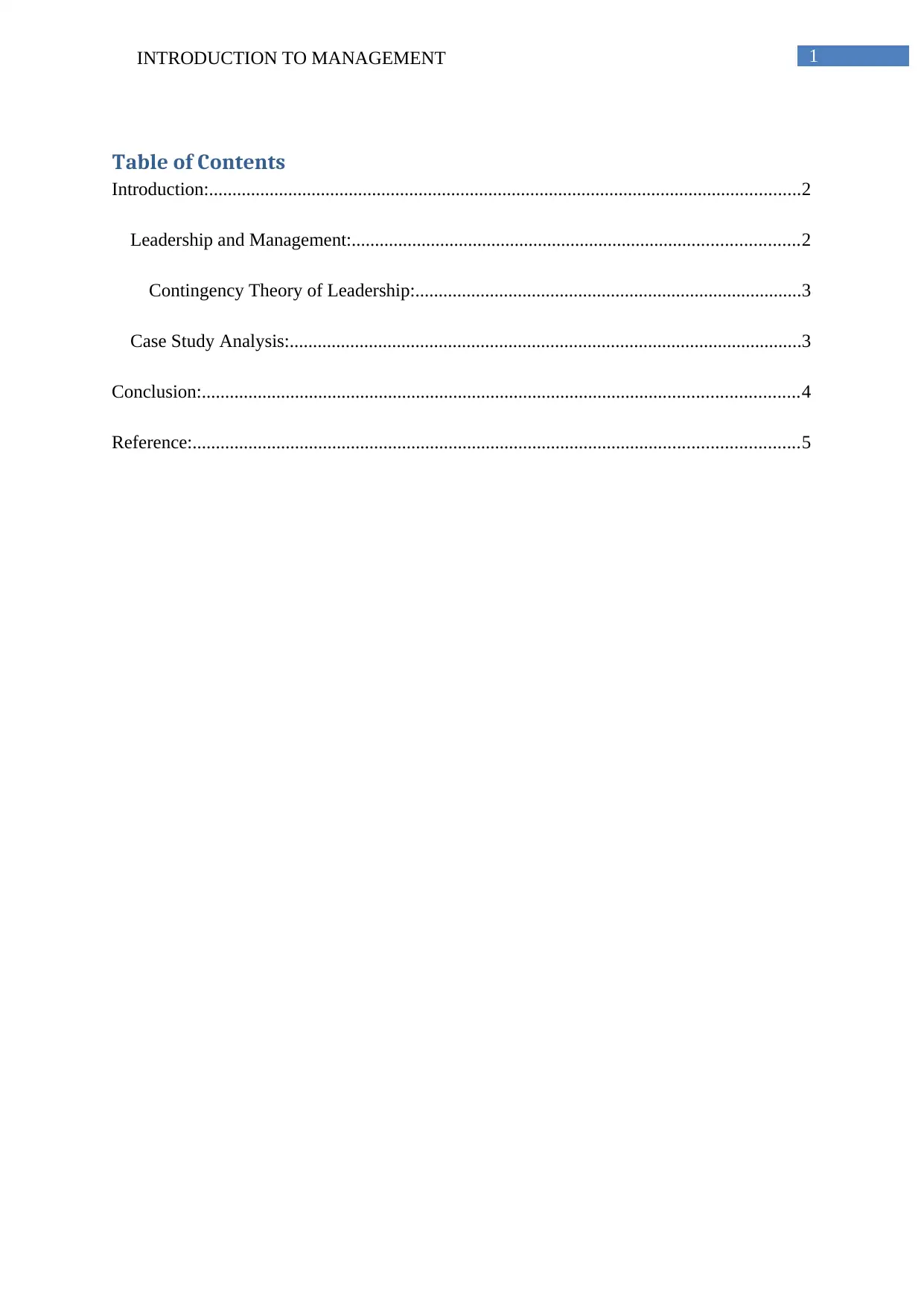
1INTRODUCTION TO MANAGEMENT
Table of Contents
Introduction:...............................................................................................................................2
Leadership and Management:................................................................................................2
Contingency Theory of Leadership:...................................................................................3
Case Study Analysis:..............................................................................................................3
Conclusion:................................................................................................................................4
Reference:..................................................................................................................................5
Table of Contents
Introduction:...............................................................................................................................2
Leadership and Management:................................................................................................2
Contingency Theory of Leadership:...................................................................................3
Case Study Analysis:..............................................................................................................3
Conclusion:................................................................................................................................4
Reference:..................................................................................................................................5
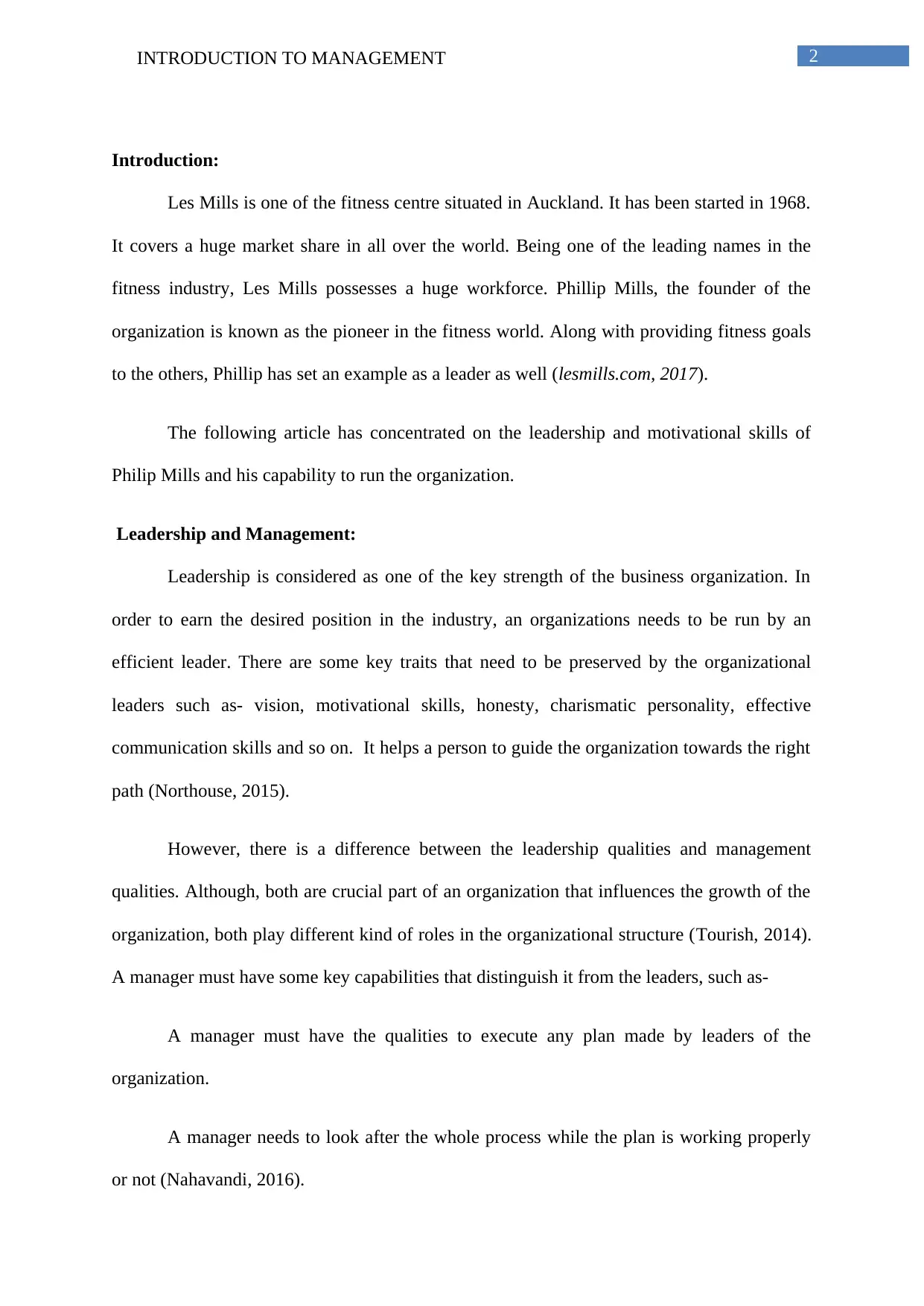
2INTRODUCTION TO MANAGEMENT
Introduction:
Les Mills is one of the fitness centre situated in Auckland. It has been started in 1968.
It covers a huge market share in all over the world. Being one of the leading names in the
fitness industry, Les Mills possesses a huge workforce. Phillip Mills, the founder of the
organization is known as the pioneer in the fitness world. Along with providing fitness goals
to the others, Phillip has set an example as a leader as well (lesmills.com, 2017).
The following article has concentrated on the leadership and motivational skills of
Philip Mills and his capability to run the organization.
Leadership and Management:
Leadership is considered as one of the key strength of the business organization. In
order to earn the desired position in the industry, an organizations needs to be run by an
efficient leader. There are some key traits that need to be preserved by the organizational
leaders such as- vision, motivational skills, honesty, charismatic personality, effective
communication skills and so on. It helps a person to guide the organization towards the right
path (Northouse, 2015).
However, there is a difference between the leadership qualities and management
qualities. Although, both are crucial part of an organization that influences the growth of the
organization, both play different kind of roles in the organizational structure (Tourish, 2014).
A manager must have some key capabilities that distinguish it from the leaders, such as-
A manager must have the qualities to execute any plan made by leaders of the
organization.
A manager needs to look after the whole process while the plan is working properly
or not (Nahavandi, 2016).
Introduction:
Les Mills is one of the fitness centre situated in Auckland. It has been started in 1968.
It covers a huge market share in all over the world. Being one of the leading names in the
fitness industry, Les Mills possesses a huge workforce. Phillip Mills, the founder of the
organization is known as the pioneer in the fitness world. Along with providing fitness goals
to the others, Phillip has set an example as a leader as well (lesmills.com, 2017).
The following article has concentrated on the leadership and motivational skills of
Philip Mills and his capability to run the organization.
Leadership and Management:
Leadership is considered as one of the key strength of the business organization. In
order to earn the desired position in the industry, an organizations needs to be run by an
efficient leader. There are some key traits that need to be preserved by the organizational
leaders such as- vision, motivational skills, honesty, charismatic personality, effective
communication skills and so on. It helps a person to guide the organization towards the right
path (Northouse, 2015).
However, there is a difference between the leadership qualities and management
qualities. Although, both are crucial part of an organization that influences the growth of the
organization, both play different kind of roles in the organizational structure (Tourish, 2014).
A manager must have some key capabilities that distinguish it from the leaders, such as-
A manager must have the qualities to execute any plan made by leaders of the
organization.
A manager needs to look after the whole process while the plan is working properly
or not (Nahavandi, 2016).
⊘ This is a preview!⊘
Do you want full access?
Subscribe today to unlock all pages.

Trusted by 1+ million students worldwide
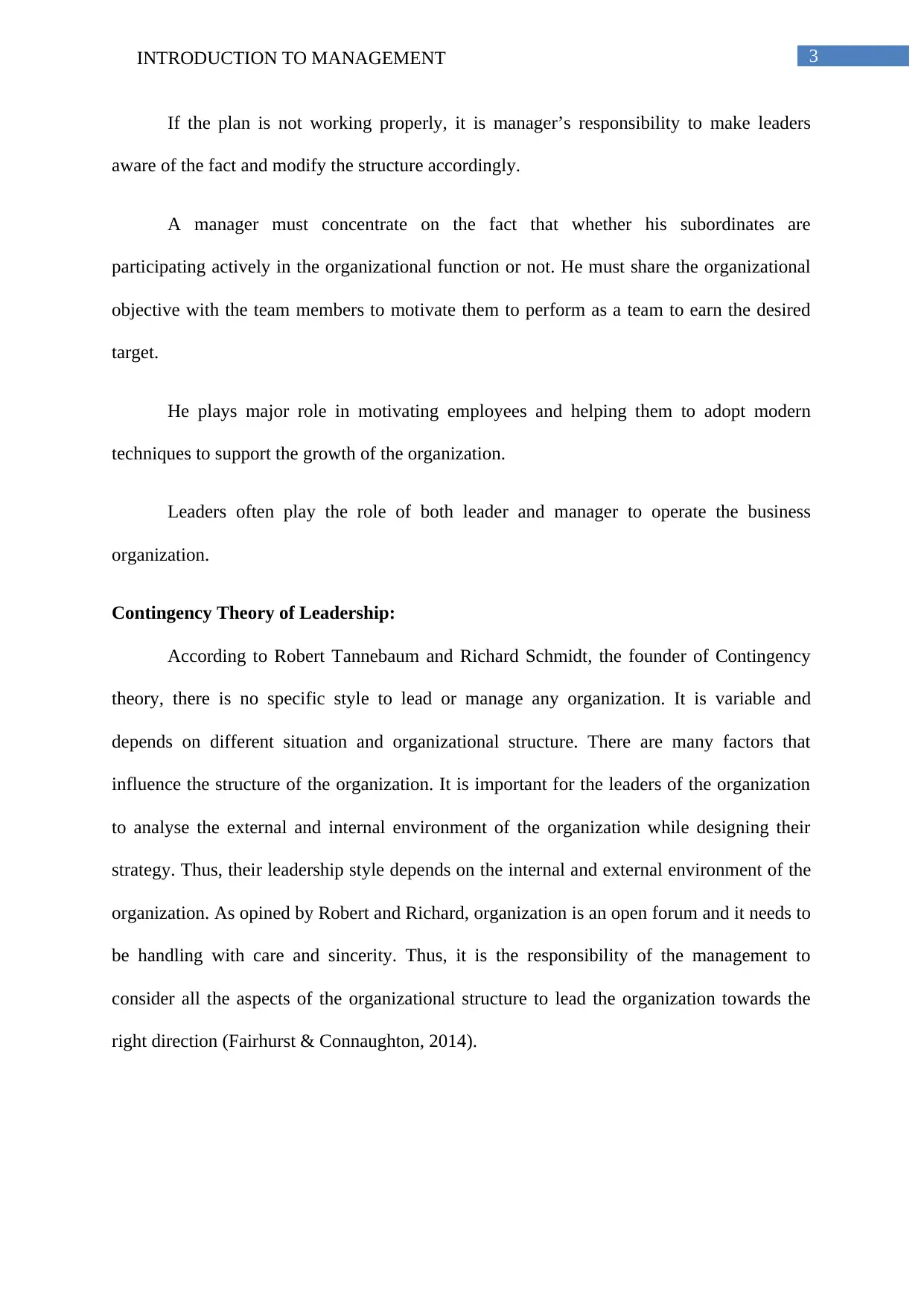
3INTRODUCTION TO MANAGEMENT
If the plan is not working properly, it is manager’s responsibility to make leaders
aware of the fact and modify the structure accordingly.
A manager must concentrate on the fact that whether his subordinates are
participating actively in the organizational function or not. He must share the organizational
objective with the team members to motivate them to perform as a team to earn the desired
target.
He plays major role in motivating employees and helping them to adopt modern
techniques to support the growth of the organization.
Leaders often play the role of both leader and manager to operate the business
organization.
Contingency Theory of Leadership:
According to Robert Tannebaum and Richard Schmidt, the founder of Contingency
theory, there is no specific style to lead or manage any organization. It is variable and
depends on different situation and organizational structure. There are many factors that
influence the structure of the organization. It is important for the leaders of the organization
to analyse the external and internal environment of the organization while designing their
strategy. Thus, their leadership style depends on the internal and external environment of the
organization. As opined by Robert and Richard, organization is an open forum and it needs to
be handling with care and sincerity. Thus, it is the responsibility of the management to
consider all the aspects of the organizational structure to lead the organization towards the
right direction (Fairhurst & Connaughton, 2014).
If the plan is not working properly, it is manager’s responsibility to make leaders
aware of the fact and modify the structure accordingly.
A manager must concentrate on the fact that whether his subordinates are
participating actively in the organizational function or not. He must share the organizational
objective with the team members to motivate them to perform as a team to earn the desired
target.
He plays major role in motivating employees and helping them to adopt modern
techniques to support the growth of the organization.
Leaders often play the role of both leader and manager to operate the business
organization.
Contingency Theory of Leadership:
According to Robert Tannebaum and Richard Schmidt, the founder of Contingency
theory, there is no specific style to lead or manage any organization. It is variable and
depends on different situation and organizational structure. There are many factors that
influence the structure of the organization. It is important for the leaders of the organization
to analyse the external and internal environment of the organization while designing their
strategy. Thus, their leadership style depends on the internal and external environment of the
organization. As opined by Robert and Richard, organization is an open forum and it needs to
be handling with care and sincerity. Thus, it is the responsibility of the management to
consider all the aspects of the organizational structure to lead the organization towards the
right direction (Fairhurst & Connaughton, 2014).
Paraphrase This Document
Need a fresh take? Get an instant paraphrase of this document with our AI Paraphraser
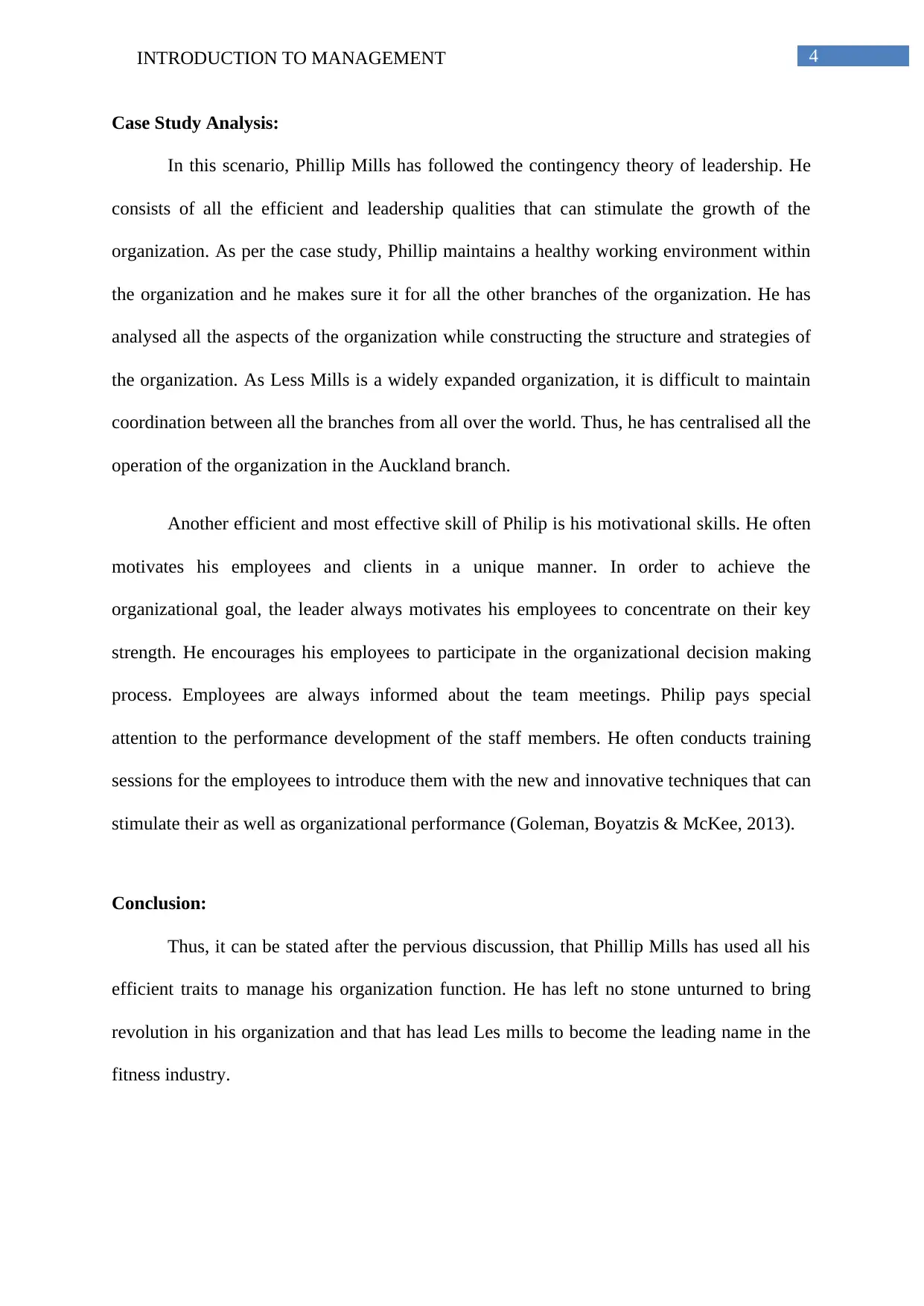
4INTRODUCTION TO MANAGEMENT
Case Study Analysis:
In this scenario, Phillip Mills has followed the contingency theory of leadership. He
consists of all the efficient and leadership qualities that can stimulate the growth of the
organization. As per the case study, Phillip maintains a healthy working environment within
the organization and he makes sure it for all the other branches of the organization. He has
analysed all the aspects of the organization while constructing the structure and strategies of
the organization. As Less Mills is a widely expanded organization, it is difficult to maintain
coordination between all the branches from all over the world. Thus, he has centralised all the
operation of the organization in the Auckland branch.
Another efficient and most effective skill of Philip is his motivational skills. He often
motivates his employees and clients in a unique manner. In order to achieve the
organizational goal, the leader always motivates his employees to concentrate on their key
strength. He encourages his employees to participate in the organizational decision making
process. Employees are always informed about the team meetings. Philip pays special
attention to the performance development of the staff members. He often conducts training
sessions for the employees to introduce them with the new and innovative techniques that can
stimulate their as well as organizational performance (Goleman, Boyatzis & McKee, 2013).
Conclusion:
Thus, it can be stated after the pervious discussion, that Phillip Mills has used all his
efficient traits to manage his organization function. He has left no stone unturned to bring
revolution in his organization and that has lead Les mills to become the leading name in the
fitness industry.
Case Study Analysis:
In this scenario, Phillip Mills has followed the contingency theory of leadership. He
consists of all the efficient and leadership qualities that can stimulate the growth of the
organization. As per the case study, Phillip maintains a healthy working environment within
the organization and he makes sure it for all the other branches of the organization. He has
analysed all the aspects of the organization while constructing the structure and strategies of
the organization. As Less Mills is a widely expanded organization, it is difficult to maintain
coordination between all the branches from all over the world. Thus, he has centralised all the
operation of the organization in the Auckland branch.
Another efficient and most effective skill of Philip is his motivational skills. He often
motivates his employees and clients in a unique manner. In order to achieve the
organizational goal, the leader always motivates his employees to concentrate on their key
strength. He encourages his employees to participate in the organizational decision making
process. Employees are always informed about the team meetings. Philip pays special
attention to the performance development of the staff members. He often conducts training
sessions for the employees to introduce them with the new and innovative techniques that can
stimulate their as well as organizational performance (Goleman, Boyatzis & McKee, 2013).
Conclusion:
Thus, it can be stated after the pervious discussion, that Phillip Mills has used all his
efficient traits to manage his organization function. He has left no stone unturned to bring
revolution in his organization and that has lead Les mills to become the leading name in the
fitness industry.
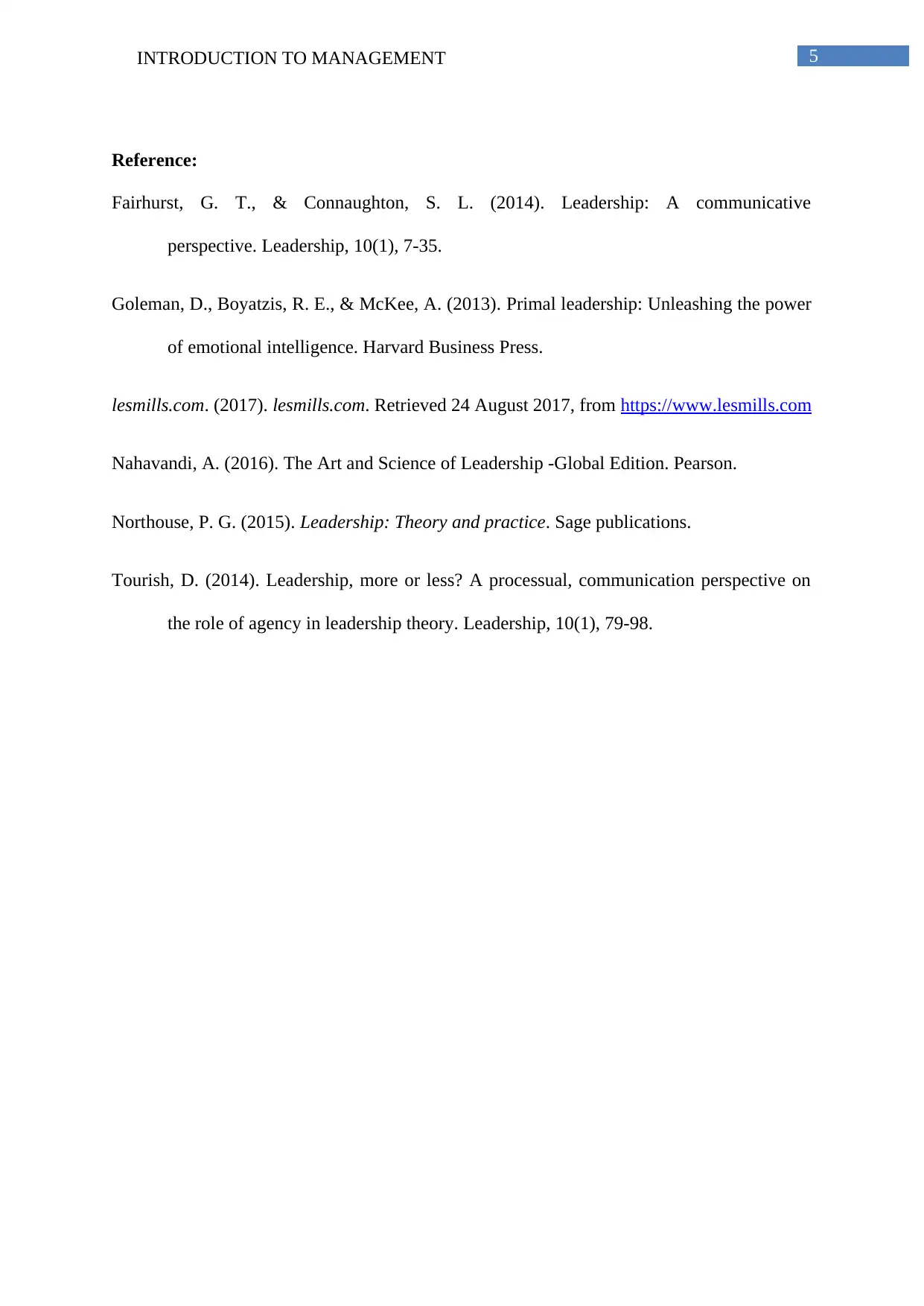
5INTRODUCTION TO MANAGEMENT
Reference:
Fairhurst, G. T., & Connaughton, S. L. (2014). Leadership: A communicative
perspective. Leadership, 10(1), 7-35.
Goleman, D., Boyatzis, R. E., & McKee, A. (2013). Primal leadership: Unleashing the power
of emotional intelligence. Harvard Business Press.
lesmills.com. (2017). lesmills.com. Retrieved 24 August 2017, from https://www.lesmills.com
Nahavandi, A. (2016). The Art and Science of Leadership -Global Edition. Pearson.
Northouse, P. G. (2015). Leadership: Theory and practice. Sage publications.
Tourish, D. (2014). Leadership, more or less? A processual, communication perspective on
the role of agency in leadership theory. Leadership, 10(1), 79-98.
Reference:
Fairhurst, G. T., & Connaughton, S. L. (2014). Leadership: A communicative
perspective. Leadership, 10(1), 7-35.
Goleman, D., Boyatzis, R. E., & McKee, A. (2013). Primal leadership: Unleashing the power
of emotional intelligence. Harvard Business Press.
lesmills.com. (2017). lesmills.com. Retrieved 24 August 2017, from https://www.lesmills.com
Nahavandi, A. (2016). The Art and Science of Leadership -Global Edition. Pearson.
Northouse, P. G. (2015). Leadership: Theory and practice. Sage publications.
Tourish, D. (2014). Leadership, more or less? A processual, communication perspective on
the role of agency in leadership theory. Leadership, 10(1), 79-98.
⊘ This is a preview!⊘
Do you want full access?
Subscribe today to unlock all pages.

Trusted by 1+ million students worldwide
1 out of 6
Related Documents
Your All-in-One AI-Powered Toolkit for Academic Success.
+13062052269
info@desklib.com
Available 24*7 on WhatsApp / Email
![[object Object]](/_next/static/media/star-bottom.7253800d.svg)
Unlock your academic potential
Copyright © 2020–2025 A2Z Services. All Rights Reserved. Developed and managed by ZUCOL.




